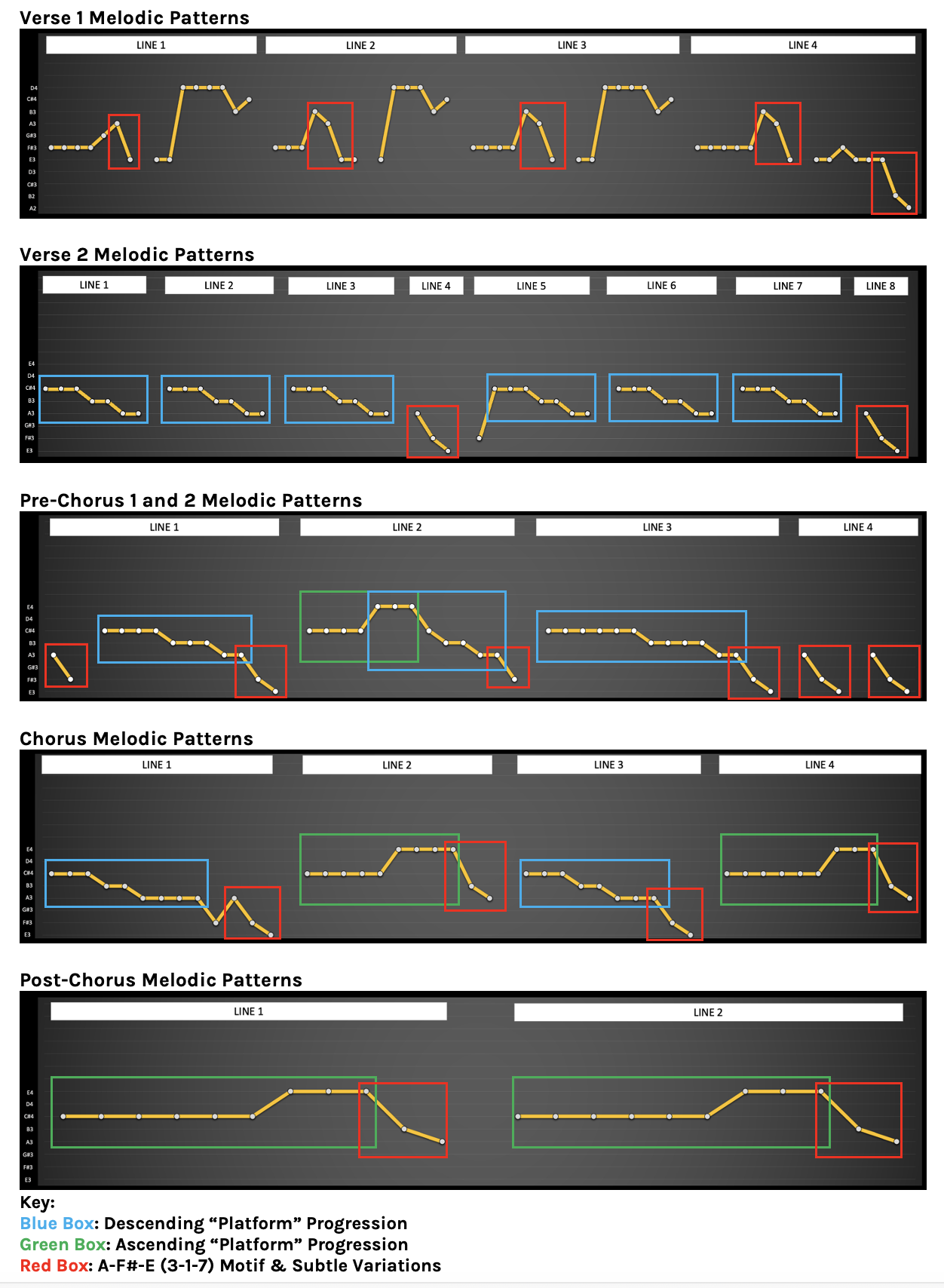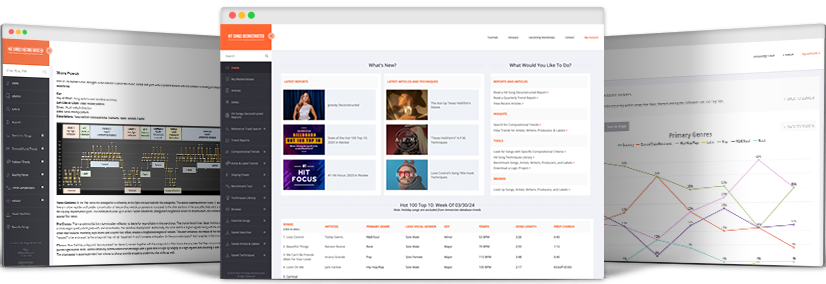"A Bar Song (Tipsy)” dominated the Billboard Hot 100 in 2024, spending 19 weeks at #1 and tying the historic record set by “Old Town Road” in 2019. While its broad appeal and undeniable catchiness contributed significantly to its success, the primary reason it’s so unforgettable lies in its abundant use of vocal repetition. Shaboozey’s melodies don’t just repeat within sections—they carry across them, creating an exceptionally cohesive and memorable song. At the same time, subtle melodic and rhythmic variations, combined with lyrical changeups, keep the track fresh and engaging from start to finish.
This analysis delves into the song’s defining motifs and repeated melodic patterns.
A-F#-E (3-1-7) Motif & Variations
The most prevalent melodic pattern in the song is the descending A-F#-E motif (scale degrees 3-1-7). This slurred motif appears throughout the verses, pre-choruses, choruses, and post-choruses, in both its proper form and in subtle variations.
Pre-Chorus
The motif first appears in its proper form in the pre-chorus, heard in both segments of the “O-h My, Go-od Lord” hook at the end of line 4. It also shows up in each of the preceding lines—some exactly (3-1-7), others with subtle fragemented shifts (3-1)—across these stretched lyrics:
- Line 1: “O-ne” (3-1) and “the fo-ur” (3-1-7)
- Line 2: “mo-ore” (3-1)
- Line 3: “dance flo-or” (3-1-7)

Chorus
In the following chorus, the motif returns at the end of lines, again in both verbatim (3-1-7) and subtly varied ways (7-4-3). This keeps the chorus sounding both fresh and familiar:
- Line 1: “Whis-ke-y” (3-1-7)
- Line 2: “a his-tory” (7-4-3)
- Line 3: “Fifth stre-et” (3-1-7)
- Line 4: “-tin’ tip-sy” (7-4-3)

Post-Chorus
The 7-4-3 variation of the motif is reinforced twice in each post-chorus via the recycled “Everybody at the bar gettin’ tipsy” song title hook from the preceding chorus.

Verse 2
After the first post-chorus, the 3-1-7 variation resurfaces in the second verse, heard in the recycled “Good Lord” pre-chorus hook at the end of lines 4 and 8.

Verse 1
A partial iteration of the motif also appears in the first verse, following a 3-7 pattern in these two-syllable lyrics:
- Line 1: “Bir-kin”
- Line 2: “groc-‘ries”
- Line 3: “work-in”
- Line 4: “prob-lems
Furthermore, the section foreshadows the 7-4-3 song title hook variation that appears in the chorus and post-chorus sections, albeit an octave below.

Descending C#-B-A (5-4-3) “Platform“ Progression
Verse 2, pre-choruses 1 & 2, and the choruses all feature a descending “platform” melodic progression that moves through three levels of stagnant notes (as seen in the melodic graphs). This progression is typically a C#-B-A (5-4-3) pattern, except for one melody in the pre-chorus that diverges with the familiar 7-4-3 pattern.
Verse 2
In verse 2, this progression comprises the entirety of lines 1–3 and 5–7.

Pre-Choruses & Choruses
In the pre-choruses and choruses, it mainly appears at the beginning of lines 1 and 3, followed by a concluding 3-1-7 motif or a subtle variation.


Preventing this repeated melodic pattern from becoming overly redundant are variations in rhythm:
- Verse 2: A fast-paced sixteenth-note rhythm drives the progression.
- Pre-Chorus: Alternates between sixteenth and eighth notes.
- Chorus: Returns to an energetic sixteenth-note rhythm.
This cross-section rhythmic variety maintains engagement and interest while reinforcing the familiar pattern.
Ascending “Platform“ Progression + Motif
In contrast, an ascending “platform” progression appears in the pre-choruses, choruses, and post-choruses. This progression features repeated notes on scale degrees 5 and 7, resolving with a variation of the 3-1-7 motif.
Pre-Chorus
The progression debuts in the pre-chorus with the lyrics, "Tell ‘em bring another round," driven by a vibrant sixteenth-note rhythm. Along with providing an engaging contrast to the preceding melodies, it foreshadows the "Everybody at the bar gettin’ tipsy" hook in the chorus.

Chorus & Post-Chorus
Both the “Everybody at the bar gettin’ (tipsy)” hook and its lyrical variant, “They know me and Jack Daniel’s got a (history),” are repeated in the chorus. This is followed by a 2× repetition in each subsequent post-chorus.


Summary
The brilliance of “A Bar Song (Tipsy)” lies in its masterful blend of repetition and variation. Anchored by the recurring A-F#-E (3–1–7) motif, the descending “platform” progression (C#–B–A / 5–4–3), and an ascending counterpart, the track stays cohesive while constantly evolving. Subtle shifts in rhythm, melody, and lyrics prevent montony, and repeated hooks—like “Everybody at the bar gettin’ tipsy”—keep listeners engaged. These elements combine to make it one of the most memorable hits of 2024.

Subscribers can view this technique in the Hit Songs Deconstructed Techniques Library by clicking here.
Not a subscriber? Click here to learn more.
Sign up to receive our free newsletter, the HSD Wire!
Empower Yourself with Cutting-Edge Tools that Give You an Edge for Success

What Industry Executives Are Saying About Hit Songs Deconstructed
"ASCAP aims to provide members with a multifaceted toolchest to augment their craft and their careers. Hit Songs Deconstructed is a cutting-edge service that can support our members' creative process with in-depth data and analysis of current songwriting techniques."
Nick Lehman
Chief Strategy & Digital Officer, ASCAP
"I find the site VERY valuable. I’m a fan."
Eric Hurt
VP, A&R Publishing / Nashville at EMPIRE
"Hit Songs Deconstructed reveals so much detail about things you might never have noticed before in hit songs, but are right in front of you. They go beyond identifying what works and explain WHY it works."
Jem Aswad
Executive Editor, Music at Variety
What Songwriters & Producers Are Saying About Hit Songs Deconstructed
"I can't stress enough how important HSD is to any serious professional hit songwriter."
Hilton Wright II
Record Producer/Songwriter, Billboard #1 RIAA Platinum & Gold winning songwriter & producer, (Drake, Mike Posner, black•𝘪𝘴𝘩)
"As a songwriter, an important part of my job is to analyze what works in successful songs. By identifying the tools that were employed in hits, writers can incorporate them into their own songs--using techniques that have proven successful--while putting their own spin and unique creative angle on them. HSD does the research for me."
Jason Blume
Songwriter w/50 million album sales
"Even though I’ve been writing professionally for over ten years, I’ve found several nuggets of gold that have improved my writing already."
Roy Stride
Hit Songwriter, Producer, Artist, One Direction, 5 Seconds of Summer, Scouting for Girls
"Spot on with the analysis and relevant to any composer, songwriter, or producer in the game now.”
Dr. O
Producer, Young M.A., Chris Brown, Lil Wayne
"I was blown away by the Max Martin Hits masterclass. So thorough and insightful - a great blend of theory and art."
Amy Sky
Recording Artist, Songwriter, Producer, 3x SOCAN-winning singer-songwriter
"I’m going on 40 years of working with top-level artists and you have made me understand even better all the things I’ve learned over the years working with them.
Thanks much for all you do."
Khaliq Glover
Grammy Award Winning Recording Engineer (We Are the World, Justin Timberlake, Christina Aguilera),
What Leading Popular Music Programs Are Saying About Hit Songs Deconstructed
“I have been giving hit record analysis exercises to my students for years, but the level of depth in a single Hit Songs Deconstructed report is a full semester’s worth of information. My entire thought process as a producer, an engineer, a musician, and a songwriter are fleshed out in the pages of the HSD reports. It is such a great tool that I’m integrating it into the songwriting and music production curriculums.”
"Prince" Charles Alexander
Grammy Award winning producer, audio engineer, recording artist and professor, Music Production and Engineering, Berklee College of Music
"The depth, detail and level of care that Hit Songs Deconstructed exercises in their song analysis is something I want my students to aspire to. I am using their analysis techniques as a benchmark for them to apply when analyzing songs, their compositional analytics to keep them in tune with what’s happening now, and the quarterly trend reports to keep them up to speed with who the key industry players are. Additionally, it’s a huge time-saver when it comes to prepping for classes. I can pick any compositional variable in the database based on what I’m going to be discussing in a lecture and easily find examples of current hits."
Chris Sampson
Founding Director, Popular Music Program, USC Thornton School of Music
"Hit Songs Deconstructed is a great teaching tool and an extremely valuable resource for my songwriting students. We’ve made it an integral part of the songwriting curriculum at MTSU and I’m thrilled to say that Middle Tennessee State University is at the forefront of songwriting education as a result of this partnership."
